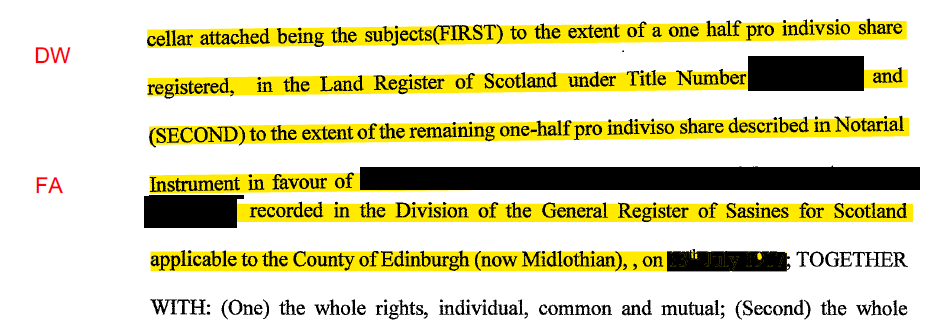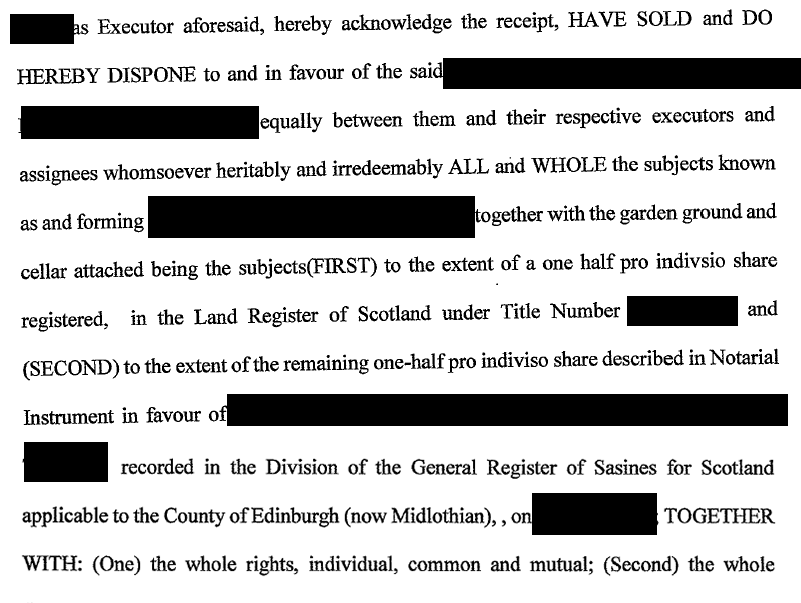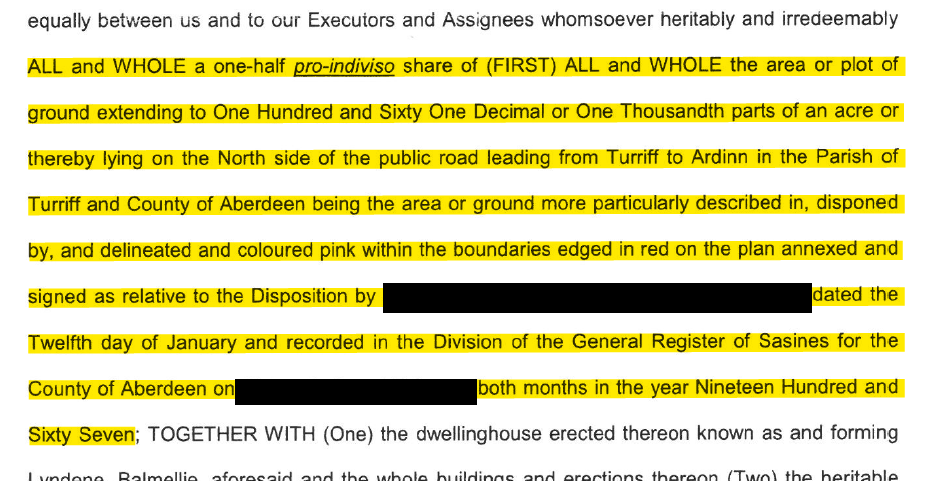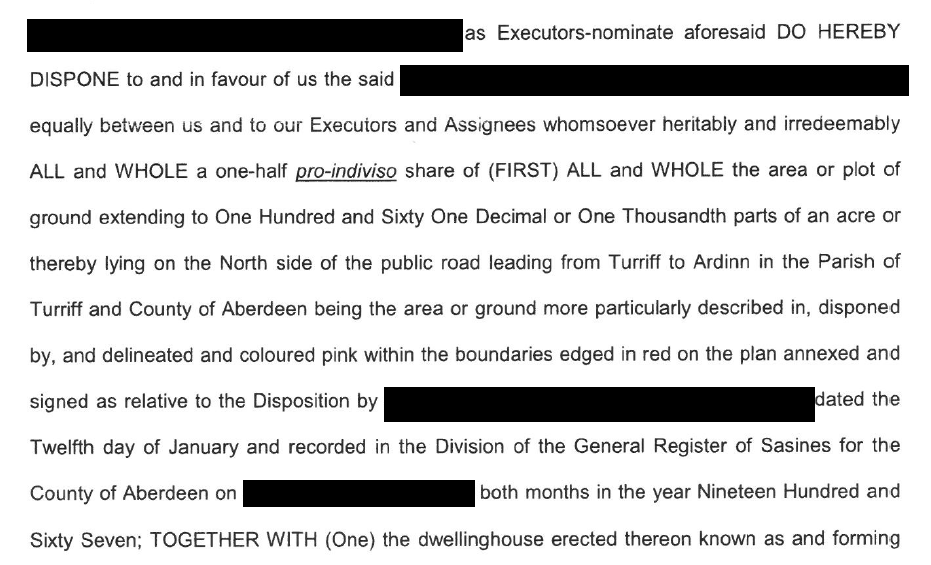Add To - PI Shares - Sift Instructions
RPT Admin (Unlicensed)
The case characteristic “Add To – PI Shares” relates to the situation where an additional ownership interest is being added to a registered title. For example:
- Valerie and Morag jointly own a cottage in Auldearn. Their title is in the sasine register. Valerie dies, and Morag inherits Valerie’s half-share of the house. Valerie’s executors transfer her half pro-indiviso share to Morag.
- Morag now owns the whole cottage, but a one half pro-indiviso share is still in sasines (this is the half which Morag originally bought) and the other one half pro-indiviso share is now in the land register (this is the half which Morag inherited from Valerie).
- When Morag dies, her executors dispone the cottage to a new family – Mr and Mrs Nowak. The deed in favour of Mr and Mrs Nowak will dispone the cottage in two half-pro-indiviso shares.
- One half pro-indiviso share will be a DW over Morag’s land registered title.
- The other half pro-indiviso share will be an FA (“first add to”) of the other half pro-indiviso share which is still in sasines.
- This second half pro-indiviso share will be added to the existing registered title.
- Once registration is complete, Mr and Mrs Nowak will own the whole of the cottage on a single registered title.
- Pauline and Arthur jointly own a flat in Polmont. Their title is in the sasine register. Pauline dies, and Arthur inherits Pauline’s half-share of the house. Pauline’s executors transfer her half pro-indiviso share to Arthur.
- Arthur now owns the whole flat, but a one half pro-indiviso share is still in sasines (this is the half which Arthur originally bought) and the other one half pro-indiviso share is now in the land register (this is the half which Arthur inherited from Pauline).
- Several years later, Arthur applies to voluntary register his remaining sasine title in the land register. This will be submitted as a VA of the half-pro-indiviso share which remained in the sasine register.
- Stephen and Shirley jointly own a garden centre in Coldstream. Their title is in the sasine register. Stephen dies, and their daughter Margery inherits Stephen’s half-share of the business. Stephen’s executors transfer his half pro-indiviso share to Margery.
- The nursery is now co-owned by Margery and Shirley. Shirley’s half pro-indiviso share is still in sasines (this is the half which Shirley originally bought) and the other half pro-indiviso share is now in the land register (this is the half which Margery inherited from Stephen).
- Some years later, Shirley decides to gift her half pro-indiviso share to Margery. She draws up a disposition of the half pro-indiviso share, and it is registered in the land register as an FA.
- Margery now owns the whole business. Her title is entirely land-registered.
How will I recognise pro-indiviso shares?
Important: the application type will be FA or VA in all examples.
The deed will generally convey the subjects in two parts. These can be described in various ways, but they are often numbered (FIRST) and (SECOND) or (IN THE FIRST PLACE) and (IN THE SECOND PLACE).
- The deed will quote a title number for the part which is already land-registered.
- The deed will quote a sasine reference for the part which is being transferred from the sasine register.
- The deed will always use the phrase pro-indiviso shares or pro indiviso shares.
- The shares can be described in various ways. “One half pro-indiviso share” is the most common description but you will also see other descriptions such as “one quarter pro-indiviso share”.
- You might also see pro-indiviso shares described using percentages. This is especially common when the pro-indiviso shares are for unusual amounts such as “a 2.5% pro-indiviso share” or “a forty seven per cent pro indiviso share”.
- Sometimes, the Further Information section of the application form might state that additional pro-indiviso shares are being conveyed.
- Sometimes, the Further Information section of the application form might ask us to add the additional pro-indiviso shares into the existing title number.
- The property description in the application form will often specify a pro-indiviso share.
- The Further Information section of the application form should state that the VR application is in respect of a pro-indiviso share.
- The Further Information section of the application form will often ask us to add the additional pro-indiviso shares into the existing title number.
- The deed will always use the phrase pro-indiviso shares or pro indiviso shares.
- The shares can be described in various ways. “One half pro-indiviso share” is the most common description but you will also see other descriptions such as “one quarter pro-indiviso share”.
- You might also see pro-indiviso shares described using percentages. This is especially common when the pro-indiviso shares are for unusual amounts such as “a 2.5% pro-indiviso share” or “a forty seven per cent pro indiviso share”.
- The property description in the application form will often specify a pro-indiviso share.
- The Further Information section of the application form should state that the application is in respect of a pro-indiviso share.
- The Further Information section of the application form will often ask us to add the additional pro-indiviso shares into the existing title number.
What about other characteristics?
You may notice other characteristics in the application – for example TCA1, minerals, or Title Number in Burdens. These points will all have been considered in full when the original PI share was registered, so there’s no need to add those characteristics again at this stage.
What else do I need to know?
Not every disposition which mentions pro-indiviso shares is an FA. Sometimes the whole of a property might be bought or sold in pro-indiviso shares. One example of this might be where a married couple have contributed differing amounts to the purchase of their home. For example:
- Patricia owns a flat in Tobermory. She has owned it for over 40 years, and her title is still in the sasine register.
- Cassie and Robin are buying Patricia’s flat. They will both contribute equally to the mortgage but Cassie has paid the deposit by herself, so their solicitor has advised them to buy the flat in unequal shares. Cassie is to purchase a 57.5% share of the flat. Robin is buying the other 42.5% share.
- Patricia grants the disposition in pro-indiviso shares – 57.5% to Cassie, 42.5% to Robin.
- The whole flat is being transferred from the sasine register to the land register so the disposition doesn’t quote any title numbers. Instead, there is a single sasine reference which applies to both pro-indiviso shares.
This is not an “Add To” application so there is no need to record the PI shares as a case characteristic.





Registers of Scotland (RoS) seeks to ensure that the information published in the 2012 Act Registration Manual is up to date and accurate but it may be amended from time to time.
The Manual is an internal document intended for RoS staff only. The information in the Manual does not constitute legal or professional advice and RoS cannot accept any liability for actions arising from its use.
Using this website requires you to accept cookies. More information on cookies.
Feedback